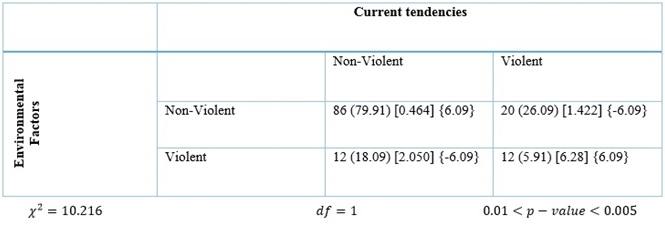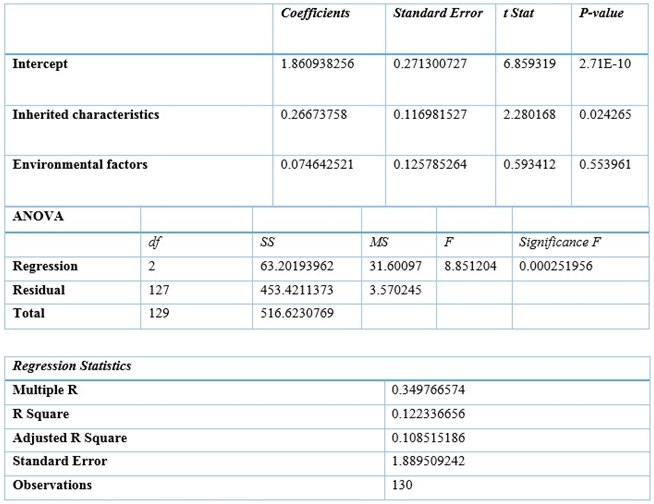-
Paper Information
- Previous Paper
- Paper Submission
-
Journal Information
- About This Journal
- Editorial Board
- Current Issue
- Archive
- Author Guidelines
- Contact Us
American Journal of Medicine and Medical Sciences
p-ISSN: 2165-901X e-ISSN: 2165-9036
2020; 10(6): 370-373
doi:10.5923/j.ajmms.20201006.04

Causative Factors for Aggressive Behavior and Violent Tendencies: Nature Versus Nurture
Shubham Patel , Miguel Miyares , Manish Mishra
Trinity School of Medicine, Trinity Medical Sciences University, Ratho Mill, St. Vincent and the Grenadines
Correspondence to: Manish Mishra , Trinity School of Medicine, Trinity Medical Sciences University, Ratho Mill, St. Vincent and the Grenadines.
| Email: |  |
Copyright © 2020 The Author(s). Published by Scientific & Academic Publishing.
This work is licensed under the Creative Commons Attribution International License (CC BY).
http://creativecommons.org/licenses/by/4.0/

For the last few decades, two hypotheses (Nurture and Nature) have strongly influenced the research on human aggressive behavior, violent tendencies, and disease onset. The nurture hypothesis states that humans acquire their behavioral violent tendencies as a result of adapting to their hostile environment such as family violence, societal violence and media violence. Whereas the nature hypothesis states that violent tendencies arise as a result of epigenetic regulation or polymorphism in important genes such as mono-amine oxidase A (MAOA), the serotonin transporter and others, which may be causative factors in the progression and maintenance of chronic violent tendencies. To compare these premises, we conducted a pilot study among young subjects, and data was collected from 130 respondents via convenience and referral sampling through an online survey. A significant correlation between the subjects’ current violent tendencies, and both the hypotheses was noted. However, inherited characteristics play a more impactful role than nurture in most participants.
Keywords: Epigenetics, DNA methylation, Gene expression, Histone modification, Polymorphism
Cite this paper: Shubham Patel , Miguel Miyares , Manish Mishra , Causative Factors for Aggressive Behavior and Violent Tendencies: Nature Versus Nurture, American Journal of Medicine and Medical Sciences, Vol. 10 No. 6, 2020, pp. 370-373. doi: 10.5923/j.ajmms.20201006.04.
1. Introduction
- Violence is one of the leading causes of injury, death and homelessness. Over the last few decades, the study of the relationship between nature and nurture in shaping human behavior has encountered a renewed interest [1]. It has been postulated that violent tendencies may arise due to distinct polymorphisms of genes that code for proteins which control neurotransmitter, metabolic and synaptic function to generate an increased risk of developing psychopathologies associated with violence. But recent advancements in the field of epigenetics reveal that experiencing aversive events during one’s life-time modulates gene expression by introducing stable changes to DNA without modifying its underlying sequence [2]. Epigenetics is a field that studies alteration of gene expression due to DNA methylation, histone modifications, chromatin remodeling, and influence of non-coding RNA’s, without affecting the sequence of nucleotides itself [1,3]. Epigenetics allows us to add on to the notion of central dogma of molecular biology, and understand that many diseases which were previously thought to be purely genetic are actually epigenetic, and caused due to influence of environment [4]. For example, experiencing adversities during periods of maximal sensitivity, such as prenatal life, infancy and early adolescence, may introduce lasting epigenetic marks in genes that affect maturation processes in brain, thus favoring the emergence of dysfunctional behaviors, including exaggerated aggression in adulthood [5]. Behavioral genetics and epigenetic regulation of four genes belonging to the neuroendocrine, serotonergic and oxytocinergic pathways - Nuclear receptor subfamily 3-group C-member 1 (NR3C1), oxytocin receptor (OXTR), solute carrier-family 6 member 4 (SLC6A4) and monoamine oxidase A (MAOA) are shedding a new light on the fine interaction between genes and environment. These genes help to understand the molecular events that underlie modulating vulnerability to proactive and reactive aggressive behavior [1,3,6-7].
2. Material and Methods
- We conducted an anonymous online survey through convenience and referral sampling and collected data of 130 participants from various age ranges, ethnicities, and nationalities. The questions in the survey aimed to answer their current tendencies for violence, the environment in which the individuals as well as their parents were born and raised, and whether they had been involved in any violent incidents. A Regression analysis and Chi-squared test were performed to determine any significant correlation between the variables.
3. Results
- The regression analysis of the sample yielded a statistically significant relationship between three variables (p-value < 0.03%), and indicated that inherited characteristics are greater contributor to aggressive behavior when compared to the environmental factors. A
 test was performed to check the correlation between current violent tendencies and environmental factors, and a value of 10.216 was obtained (statistically significant at
test was performed to check the correlation between current violent tendencies and environmental factors, and a value of 10.216 was obtained (statistically significant at  ). Similarly, a
). Similarly, a  was also performed to check the correlation between current violent tendencies and inherited characteristics, and a value of 4.986 was obtained (statistically significant at
was also performed to check the correlation between current violent tendencies and inherited characteristics, and a value of 4.986 was obtained (statistically significant at  ). Based on the survey data, a regression analysis was also completed to predict violent tendencies, and check if there are any other factors that would contribute to an individual’s violent tendencies. Hence, the following equation (p-value <0.003) can help to predict one’s subjective violent tendencies (on a scale of 1-10, where E = environmental factors, and I = inherited characteristics).
). Based on the survey data, a regression analysis was also completed to predict violent tendencies, and check if there are any other factors that would contribute to an individual’s violent tendencies. Hence, the following equation (p-value <0.003) can help to predict one’s subjective violent tendencies (on a scale of 1-10, where E = environmental factors, and I = inherited characteristics).
4. Discussion
- In 2005, researchers at the Spanish National Cancer Center studied the epigenetic markers in 40 pairs of monozygotic twins and observed that although the twins were not epigenetically differentiable during the early years of their life, but older monozygotic twins exhibit notable differences in their overall content and genomic distribution of 5-methylcytosine DNA and histone acetylation, affecting their gene-expression portrait [8]. Watanabe et al. (2016) observed the DNA methylation pattern in 30 male and 43 female older monozygotic twin pairs, and reported that the sex-related differences were present within-pair for methylation levels of CpG islands in individuals with the same genetic background [9]. These studies revealed that our gene expressions can be altered by our experiences (environmental factors), and as we all have our own different set of experiences which affect our genes via epigenetic mechanisms.Aggressive behavior is the observable manifestation of aggression and is often associated with developmental transitions and a range of medical and psychiatric diagnoses across the lifespan. Aggression can be nurtured by stressful or traumatic life events, and is essential to deal with life threatening scenarios to preserve one’s own being [10]. Nevertheless, if uncontrolled, it denotes a pathological condition which can be characterized by conduct disorders and psychopathy [11]. Exposure to aversive environments during childhood and adolescence is one factor that has been linked to the development of lifelong aggressive behaviors and psychiatric disorders in adulthood [1,12]. The other factor being the inheritance of violent tendencies from our ancestors. Which one plays a bigger role?The
 values of 10.216 and 4.986 for violent tendencies arising due to environmental factors and inherited genes, respectively, are both significant at
values of 10.216 and 4.986 for violent tendencies arising due to environmental factors and inherited genes, respectively, are both significant at  (Table. 1; Table. 2). Hence, both factors are needed to explain the behaviors of the sample subjects, and this was expected and is consistent with prior literature that states nature and nurture should not be regarded as two separate factors, but the combination of the two can explain our actions more precisely [13-14].
(Table. 1; Table. 2). Hence, both factors are needed to explain the behaviors of the sample subjects, and this was expected and is consistent with prior literature that states nature and nurture should not be regarded as two separate factors, but the combination of the two can explain our actions more precisely [13-14].
|
|
 was compared to the adjusted
was compared to the adjusted  , it revealed that addition of alternative predictors generates an imprecise regression, therefore it can be inferred that the only variables that impact human violent tendencies are environmental factors and inherited characteristics.
, it revealed that addition of alternative predictors generates an imprecise regression, therefore it can be inferred that the only variables that impact human violent tendencies are environmental factors and inherited characteristics.
|
5. Conclusions
- Altogether it is clearly indicative that when it comes to human behavior, nature and nurture are not to be regarded as two distinct and separate factors, contrary to the alternating predominance of either one that has been proposed in different historic phases. Indeed, distinct genetic backgrounds differentially modulate the individual susceptibility to the environment and at the same time various environmental conditions differentially affect gene expression, in an intimate and fascinating manner that scientists have now begun to disentangle.
 Abstract
Abstract Reference
Reference Full-Text PDF
Full-Text PDF Full-text HTML
Full-text HTML

